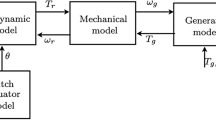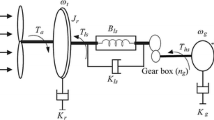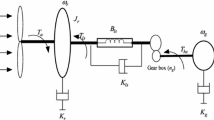Abstract
Blade tip clearance (BTC) is one of the key factors affecting the efficiency and reliability of high performance turbomachinery such as heavy duty steam turbines, aircraft engines and other gas turbo machines. The self-adjusting ability of BTC according to the operation condition changing is important to meet the requirement of performance. In this paper, the principle and method of adjusting the BTC by controlling the axial displacement of the rotor were proposed and studied. The basic principle is that the BTC of the turbomachinery with a conical tail shroud will be affected by the axial displacement of rotor and thereby can be adjusted by controlling the axial position of rotor, which can be adjusted by the controllable oil pressure acting on the thrust bearing. To reach a higher control precision, lower noise and model perturbation, an adaptive quasi-sliding mode control (AQSMC) algorithm based on the disturbance observer (DOB) was designed, and numerical and experimental investigations were carried out. The numerical simulation results show that this algorithm can not only effectively suppress the disturbance, but also, compared with the general reaching law, effectively reduce the chattering and transient high gain switching effect of the closed-loop controller system and avoid the instability caused by the controller. Based on the DOB-AQSMC algorithm, the BTC was stabilized within 2 s with no overshoot and no misalignment in the test rig, and this algorithm achieves a better control performance than the proportion-integral-differential (PID) algorithm. These achievements can be used to push forward the intelligent turbomachinery development.
Similar content being viewed by others
References
Liu Y Y, Slotine J J, Barabási A L. Controllability of complex networks. Nature, 2011, 473: 167–173
Wang T R, Zhang Y, Yu H B, et al. Advanced manufacturing technology in China: A roadmap to 2050 (in Chinese). Beijing: Science Press, 2010
Culley D, Garg S, Hiller S J, et al. More intelligent gas turbine engines. RTO Technical Report. TR-AVT-128, 2009
Xie F. Effect of tip clearance on stall and circumferential single grooves improving the stability on axial-flow compressors (in Chinese). Dissertation for the Doctoral Degree. Xi’an: Northwestern Polytechnical University, 2015. 84–90
Sa Y L. Stability improvement of a turbo-charger centrifugal compressor by tip leakage control. Dissertation for the Doctoral Degree. Beijing: Tsinghua University, 2016. 6: 2–9
Niu M S, Zang S S. Active control of tip clearance flow through casing air injection in axial turbines. J Energy Inst, 2016, 84: 44–51
Jiang J, Chen Y H. Advances in the research on nonlinear phenomona in rotor/stator rubbing systems (in Chinese). Adv Mech, 2013, 43: 132–148
Matta R K, Mercer G D, Tuthill R S. Power systems for the 21st century-“h” gas turbine combined-cycles. GE Industrial and Power System Report. GER-3935B, 2000
He F Y. Research on control development and key technology of heavy gas turbine (in Chinese). Sci Technol Inform, 2017, 15: 43–44
Gu W, Qiang J, Chen X, et al. A review of turbine clearance control system for civil turbofan engine (in Chinese). Gas Turb Technol, 2013, 26: 1–4
Melcher K, Kypuros J. Toward a fast-response active turbine tip clearance control. NASA Technical Report. NASA/TM-2003-212627, 2004
Decastro J, Melcher K. A study on the requirements for fast active turbine tip clearance control systems. NASA Technical Report. NASA/ TM-2004-213121, 2004
Steinetz B M, Lattime S B, Taylor S, et al. Evaluation of an active clearance control system concept. NASA Technical Report. NASA/ TM-2005-213856, 2005
Sridhar A, Steven E D, Gerhard M G, et al. Method, system, and apparatus for reducing a turbine clearance. GB Patent, 2552048A, 2017-09-12
Clarke B C, Laborie D J. Method and apparatus for active clearance control on gas turbine engines. US Patent, 0030987A1, 2018-02-01
Arnold J, Philbrick G R, Couture P D. Thrust rating dependent active tip clearance control system. EP Patent, 3358144A1, 2018-08-08
Griffin D R, Barker J E, Chrisikos J P, et al. Active clearance control collector to manifold insert. US Patent, 0051583A1, 2018-02-22
Luo Z, Zhu Y, Zhao X, et al. Determining dynamic scaling laws of geometrically distorted scaled models of a cantilever plate. J Eng Mech, 2016, 142: 04015108
Ma Y, Liu H, Zhu Y, et al. The NARX model-based system identification on nonlinear, rotor-bearing systems. Appl Sci, 2017, 7: 911
Liu B, Wang W, Zhang Y, et al. Investigation on axial displacement fault mechanism based on dynamic characteristic coefficients identification of tilting-pad thrust bearing. J Fail Anal Preven, 2018, 18: 330–341
Acknowledgments
This work was supported by the National Natural Science Foundation of China (Grant Nos. 51775030 & 11802153), and the Fundamental Research Funds for the Central Universities (Grant No. BHYC1703A).
Author information
Authors and Affiliations
Corresponding author
Rights and permissions
About this article
Cite this article
Wang, W., Shao, X., Li, Q. et al. Research on active disturbance rejection control method for turbine blade tip clearance. Sci. China Technol. Sci. 62, 1795–1804 (2019). https://doi.org/10.1007/s11431-018-9431-x
Received:
Accepted:
Published:
Issue Date:
DOI: https://doi.org/10.1007/s11431-018-9431-x




